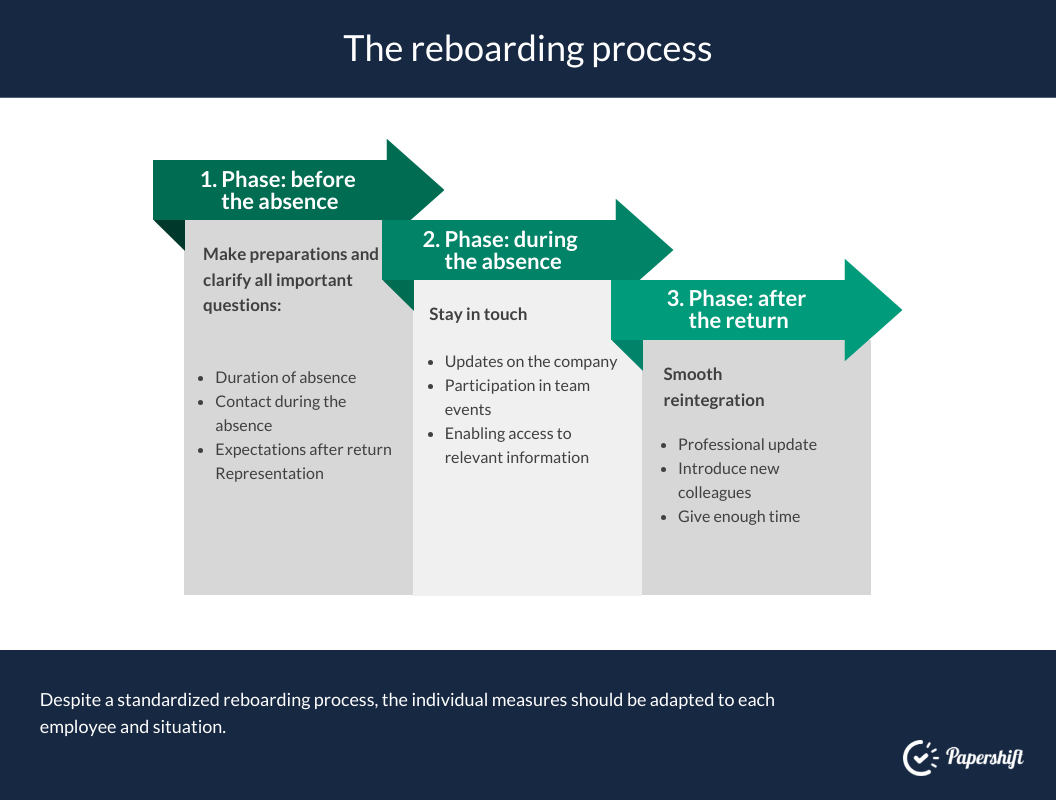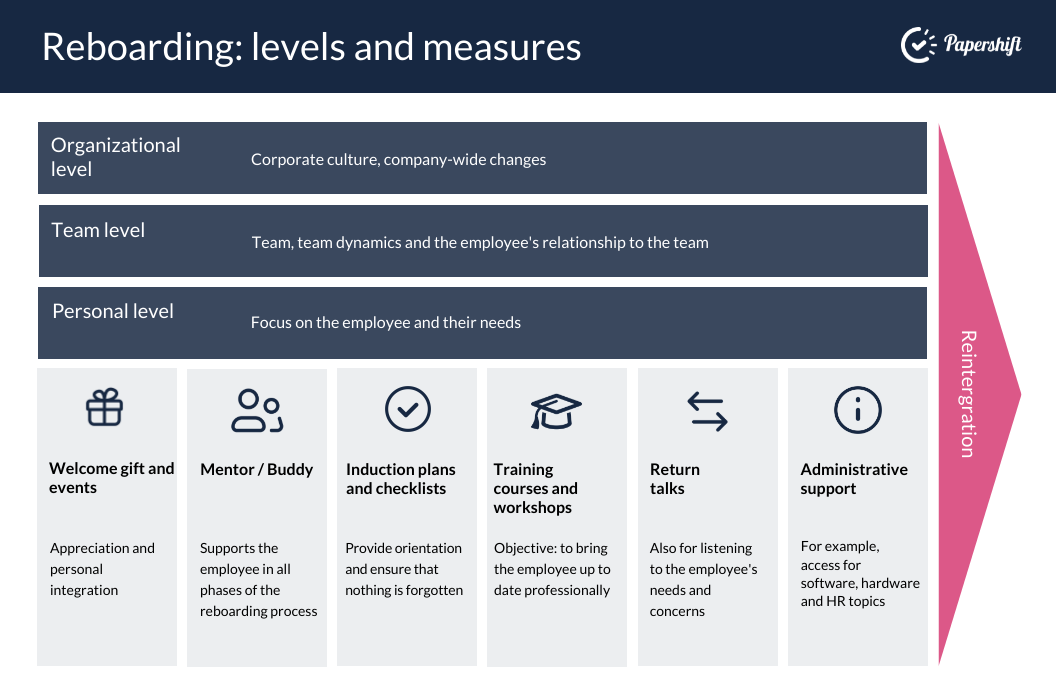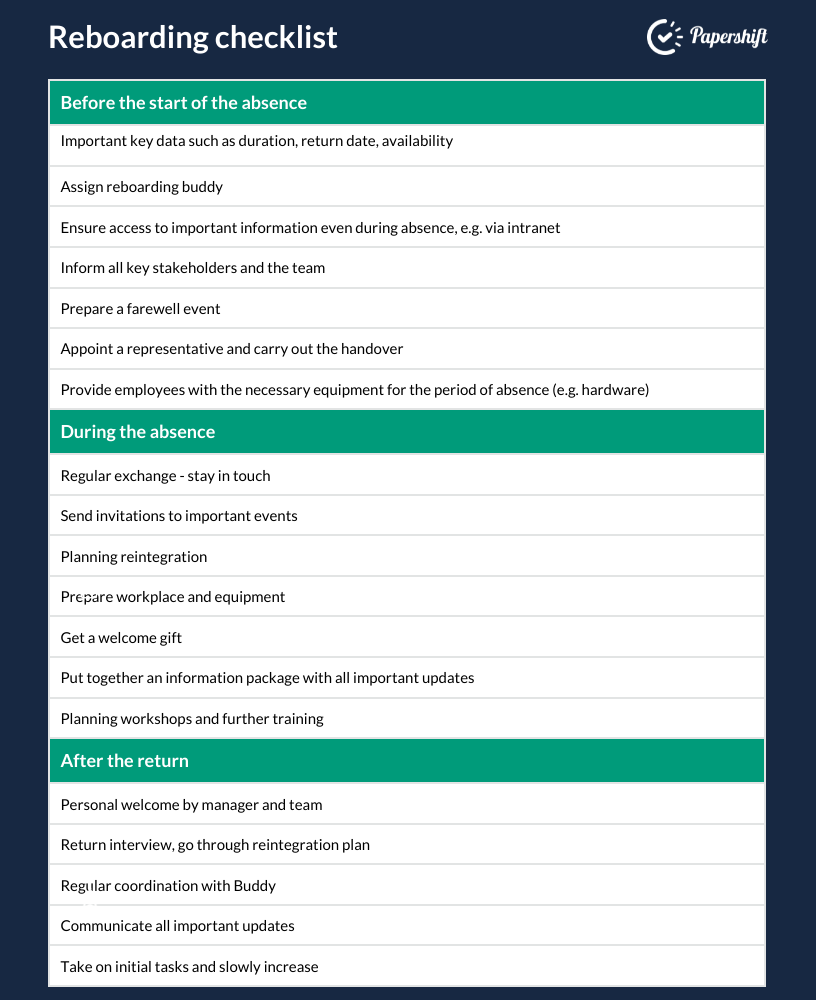
Jump to
- Definition of reboarding
- After which absences is reboarding advisable?
- Why reboarding is essential for companies
- Advantages of reboarding for employees
- The phases of the reboarding process
- Despite standard processes, reboarding should be individualized
- How long does effective reboarding take?
- The importance of reboarding in today’s work environment
- Reboarding at various levels: individual, team, and organization
- The legal framework for rear-facing car seats in Germany
- Support for reboarding through HR software
- Reboarding-Checklist
What is reboarding, what needs to be considered when reintegrating employees, and what should never be forgotten? You can find out all this in our guide—complete with process and checklist.
Qualified and loyal employees are the key to success for companies. However, skills shortages and demographic change are making good staff an increasingly scarce resource. In this context, the successful reintegration of employees after a long absence is becoming increasingly important. Reboarding plays an important role in this.
Definition of reboarding
Reboarding describes the structured process of reintegrating employees into a company after they have been absent for an extended period of time, for example, due to parental leave, prolonged illness, or a sabbatical. The term “reboarding” is also used synonymously with return-to-work management. The primary goal of reboarding is to make the transition back to work as smooth as possible for the employee and to help them reintegrate into the team and corporate culture. This includes various measures aimed at familiarizing them with changed processes, providing professional training, and reintegrating them socially into the team.
Reboarding is not to be confused with the term reintegration. While reintegration is a general term for the integration of employees after a prolonged absence, for example due to illness, reboarding describes specific measures and processes to make reintegration successful for both employees and companies.
Although reboarding has similarities with the onboarding process for new team members, there is one important difference: reboarding is aimed at people who were already part of the company. Unlike onboarding, which is about introducing new employees to the company for the first time, reboarding focuses on refreshing the knowledge of returning employees, informing them about changes in processes and responsibilities, and providing them with the necessary guidance and reassurance for their return.
After which absences is reboarding advisable?
Reboarding is useful and necessary in a variety of situations where employees have been absent from work for an extended period of time.
- Returning to full-time work after part-time work: When employees increase their working hours from part-time to full-time, reboarding can help them readjust to a higher workload and possibly changed responsibilities.
- After prolonged illness: Comprehensive reboarding supports employees in reintegrating into everyday working life after a prolonged absence due to illness. The focus here is on both a gradual increase in performance and social and professional reintegration.
- After parental leave or maternity leave: Returning to work after a family break often requires adapting to changed working hours, new responsibilities, and possibly also a changed corporate culture.
- After a sabbatical: After a prolonged break for personal or professional development, reboarding helps to integrate the insights gained into everyday working life and to settle back into the company.
- Returning from short-time work: For employees who have been working reduced hours for an extended period, reboarding is important in order to reintroduce them to their original tasks.
- Internal job change or transfer: Even when employees take on a new position within the company, a reboarding-like process is useful for integrating them into their new tasks and the new team.
- Foreign assignment: Here, reboarding can help prepare employees for the changed working conditions and cultural differences or facilitate their reintegration into the company at home.
- Returning after moving to another company (rehiring): When former employees return to their original company, a reboarding process is recommended to prepare them for changed working methods, processes, and structures.
- Returning from working from home: When returning to the office after a long period of remote work or when switching to hybrid working models, reboarding helps employees get used to a new environment and processes.
Why reboarding is essential for companies
An effective reboarding process not only makes it easier for the employees concerned to return to work, but also contributes significantly to the success of the company.
Through structured reintegration, returnees are quickly reintroduced to their tasks and can thus make a valuable contribution again sooner. In addition, changes in the company and new developments are effectively communicated, allowing employees to quickly feel up to date again. This gives returnees orientation and security in a potentially changed work environment. False starts after re-entry can thus be significantly reduced, while misunderstandings, conflicts, and associated negative experiences occur much less frequently.
This benefits employer branding because companies that take care of their returning employees are perceived as attractive employers. This increases employee retention and team spirit, strengthens loyalty, and, above all, the emotional connection between employees and their employer. In the long term, reboarding can reduce turnover in the company and thus lower the costs of recruitment and training.
Advantages of reboarding for employees
Many of the advantages mentioned above that structured reboarding offers companies also have a direct impact on employees. After a long break, reboarding helps employees get back into the swing of things, both professionally and emotionally. This avoids or at least significantly reduces the feeling of being thrown in at the deep end.
Employees also feel valued when the company makes an effort to ensure a smooth reintegration. They feel that they are important to their employer. This feeling promotes motivation and performance.
The phases of the reboarding process
Reboarding is divided into several phases. These cover the period from the start of the absence until the employee is fully reintegrated.
First phase: before the start of the absence
The first phase of reboarding takes place before the employee’s absence. During this phase, an open discussion should take place between the employee and their supervisor to discuss the upcoming time off. Important topics include the duration of the absence, the distribution of tasks during this time, and contact options.
Other topics to be clarified during this phase may include:
- Training opportunities during the leave of absence
- Managing expectations for the period after the employee’s return
- Creating a reboarding plan
In the case of an internal job change, it is advisable to contact the new team at an early stage. In addition, an information package for the employee’s return should be prepared at this point.
Second phase: during absence
The second phase of reboarding covers the period of absence. Here, it is important to maintain regular contact with the employee, for example by email or telephone. The absent employee should be kept informed about important developments and changes in the company. Invitations to team events and training courses can be offered as an option. Access to relevant information, for example via the intranet, should also be provided.
Third phase: from return to successful reintegration
The third phase begins after the employee returns. A warm welcome on the first day lays the foundation for a successful reintegration. The current team and, if applicable, new colleagues should be introduced. Training begins according to the plan that has been drawn up. Regular check-ins and feedback meetings should be held. Assigning a mentor or buddy can be particularly helpful during this phase. Last but not least, open channels of communication should be established so that questions and concerns can be addressed at any time. The returnee should be given sufficient time to readjust and no unnecessary pressure should be exerted. Regular reflection meetings can help to monitor progress and make adjustments if necessary.
Despite standard processes, reboarding should be individualized
The needs of an employee returning from parental leave differ significantly from those of someone returning to work after a sabbatical or prolonged illness. A personalized approach ensures that the reporting process is tailored to the individual needs of each employee.
An individual reboarding process can also be based on a standardized process. This ensures that all relevant measures are taken. The design of the individual measures can be customized as needed. For example, for an employee who does not like to be the center of attention and prefers a quiet environment, a large welcome event can be dispensed with and individual meetings organized instead.
How long does effective reboarding take?
How long it takes to successfully complete reintegration depends on various factors. These include the length of the employee’s absence, the extent of changes that have taken place in the company during this time, and the employee’s specific position and associated tasks. The complexity of the activities and the individual needs of the returnee also play an important role in determining the optimal reboarding duration.
In many cases, it makes sense to draw up a structured plan covering several weeks or even months to ensure comprehensive reintegration. In the case of a longer illness, gradual reintegration, as provided for in the Hamburg model, for example, can take up to six months. It is crucial to give the returning employee enough time to adapt to the changed circumstances and not to put unnecessary pressure on them to immediately perform at full capacity again. Patience and flexibility are the keys to successful reboarding.
On the other hand, a hasty reintegration can overwhelm the returning employee and hinder their reintegration. Sufficient time for adjustment and flexibility in the reboarding plan, based on the employee’s progress and feedback, lead to better results.
The importance of reboarding in today’s work environment
Companies are increasingly recognizing that careful reintegration is not only beneficial for the individual employee, but also for the entire team and the company as a whole. A well-designed reboarding process has a positive impact on collaboration and the working atmosphere.
Rapid changes
Many companies and industries today are characterized by a high degree of dynamism. Processes, products, and tasks can change rapidly. Even during a relatively short absence of an employee from the company, fundamental processes, structures, or technologies may have evolved—for example, through the use of AI or due to new legal regulations. This must be taken into account during reboarding.
Homeoffice and Remote Work
The COVID-19 pandemic has brought about lasting changes in the way we work, with new working models such as home office and hybrid forms of work becoming established. As a result, reboarding is not only relevant after traditional absences such as parental leave or sick leave, but also becomes necessary when returning to the office after a period of remote work or when switching to new hybrid working models.
Reboarding at various levels: individual, team, and organization
Successful reboarding takes into account various levels within the company: the individual level of the employee, the team to which they are returning, and the overall organizational level.
Individual level
At the individual level, the focus is on the individual employee with their specific needs and circumstances. This includes creating individual reintegration plans and conducting personal return-to-work interviews. To ensure that the employee quickly gets back up to speed, targeted training and further education to update knowledge and skills are essential.
Assigning a mentor or buddy can also provide valuable support and ensure smooth social integration.
Team level
At the team level, the main focus is on restoring team dynamics and cooperation. This includes introducing new team members and communicating changes within the team. Team-building activities and social integration measures can help to restore a sense of belonging. Clear communication of expectations and goals within the team is also important.
Organizational level
At the organizational level, the focus is on communicating company-wide changes. Examples include new strategies, structures, or changes in corporate culture, as well as adjustments to processes, guidelines, and the tools used.
A positive and supportive corporate culture ensures that returnees feel welcome and valued.
Communication is a key element at all three levels of reboarding. Whether in individual conversations, team meetings, or company-wide announcements, clear, consistent, and empathetic communication is crucial to keeping returning employees informed, addressing their concerns, and fostering a sense of belonging.
The legal framework for rear-facing car seats in Germany
Although there are no specific laws in Germany that explicitly address the issue of reboarding, various labor law provisions and guidelines are relevant that companies must take into account when designing their reboarding process.
Employment law aspects
Several general labor law provisions are relevant in Germany in connection with reboarding. For example, employees are generally entitled to their old job or a comparable position after a prolonged illness. The General Equal Treatment Act (AGG) must be observed, which prohibits discrimination against employees on the basis of their illness.
If an employee is unable to work for more than six weeks within a year, the employer is obliged under Section 167 of SGB IX to offer a company integration management program (BEM). The purpose of this program is to work with the employee concerned to find ways of overcoming their inability to work and retaining their job. Within the framework of the BEM, reintegration can also be agreed upon according to the so-called Hamburg model, which enables the employee to gradually return to their daily work routine. In consultation with the doctor, the workload is gradually increased.
After parental leave, employees are generally entitled under Section 15 (5) BEEG to return to the working hours agreed upon before the start of parental leave. Under certain circumstances, they may also be entitled to part-time work and flexible working hours after parental leave.
Data protection and information security
As part of the reboarding process, the provisions of the General Data Protection Regulation (GDPR) must be complied with, particularly when accessing and processing employee data. This applies in particular to sensitive health data that is collected and processed as part of the BEM. Special regulations regarding data protection and data security must also be observed when working from home.
Support for reboarding through HR software
For successful, targeted, and efficient reboarding, we recommend using suitable HR software such as Papershift Pulse. In addition to convenient document management, this software also offers the option of maintaining a digital personnel file and a communication platform that allows you to stay in touch even when employees are absent.
The management of checklists is also particularly helpful. This ensures that no important tasks are forgotten during reboarding.
Reboarding-Checklist
To ensure that nothing is forgotten during reintegration, a checklist with the most important reboarding tasks can be used. Below is an example of such a checklist.
Summary
- Reboarding ensures the structured and targeted reintegration of employees.
- Effective reboarding is important, for example, after a sabbatical, parental leave, or prolonged illness.
- Reboarding affects various levels.
- A combination of a process with fixed phases and individual measures is optimal.



